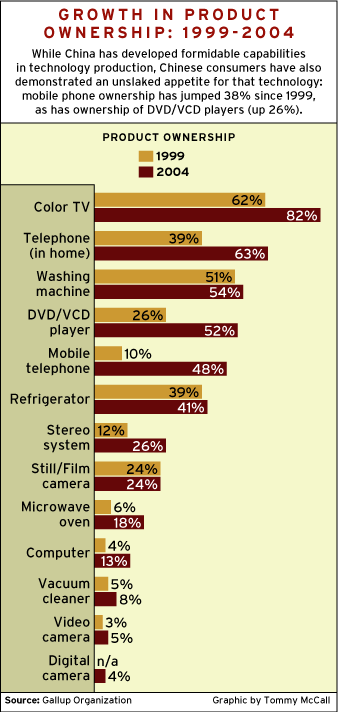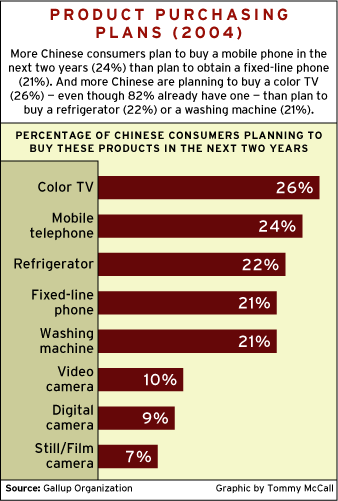For economists and sociologists, certain signs typically point to the march of modernization around the globe. Among these are an increase in the number of households that own various labor-saving consumer goods, including durable goods (such as washing machines, dryers, and refrigerators) and household appliances that seem to signify a modern lifestyle (such as vacuum cleaners and in-home telephones).
These conventional harbingers of societal development are evident in China, as revealed by The Gallup Organization's surveys in that country over the past decade. When we take a close look at individual products, however, it becomes apparent that not all of these consumer goods are being purchased at an equal rate: Some are sprinting headlong down the path to modernization, while others are merely strolling along. The sprinter products are the more cutting-edge consumer goods, which reflect the lure of tomorrow's technology.
While China has been developing formidable capabilities in technology production, the Chinese population has also been demonstrating an unslaked thirst for that technology. Chinese consumers, as well as the world-export markets, are seeking the advanced electronics that China aims to produce. And this trend isn't limited to consumers in the big cities such as Beijing and Shanghai -- the entire nation is embracing a great leap forward in modern technology.
More computers than vacuum cleaners
 |
The percentage of households that own a refrigerator crept up from 39% to 41% from 1999 to 2004, continuing the steady growth evident since Gallup's first national survey in China in 1994. Growth in washing machine ownership has also edged up a bit (from 51% to 54%), and vacuum cleaners are now in 8% of homes versus only 5% in 1999.
But contrast that slow and steady growth with that of more technological products: DVD/VCD (video compact disk) ownership has doubled, from 26% to 52%, in the same time span. Ownership of stereo systems has more than doubled (from 12% to 26%), and microwave oven ownership has tripled, from 6% to 18%. Since 1999, computer ownership has more than tripled (from 4% to 13%). Computers are now found in more Chinese homes than vacuum cleaners!
As reported elsewhere, access to and use of the Internet has virtually exploded; China is well on its way to being the world's largest Internet community. (See "Internet Use: Behind 'The Great Firewall of China'" in See Also.) These explosions in product growth are happening not just in the world of computers, but also wherever new technologies promise or provide considerable advantages -- in image as well as performance -- over traditional technologies.
What's more, while there has been no increase in ownership of traditional film (still) cameras since 1999 (ownership has held steady at 24%), ownership of video cameras is on the rise (up slightly from 3% to 5%). The same is true of digital cameras (now at 4%). And these products seem to be poised for real growth: About 1 in 10 consumers state that they plan to buy a video camera (10%) or digital camera (9%) in the next two years. Somewhat fewer (7%) Chinese consumers indicate an intention to purchase a still/film camera -- half of the 14% who planned to buy a still camera in 1999. In China, it appears that the digital world is breezing past the analog world.
Going mobile
 |
Similar trends can be seen in telecommunications, where the prevalence of in-home telephones grew from 39% in 1999 to 63% in 2004. But the growth rate for mobile phones was even more impressive, skyrocketing from only 10% in 1999 to 48% in 2004 -- and more Chinese consumers now plan to buy a mobile phone (24%) than plan to purchase a fixed-line phone (21%). In addition, more Chinese consumers are planning to buy a color TV (26%) -- even though 82% already have one -- than plan to buy a refrigerator (22%) or a washing machine (21%).
In China, it seems that the promise of tomorrow's technology isn't merely a dream. It's a reality. China may well value its traditions, but its great leap forward into the 21st century seems anything but traditional.
In this new millennium, the signals of China's development are less likely to be washing machines and vacuum cleaners. Rather, the hallmarks of the country's modernization are the mobile phones, digital cameras, and computers that are making their way into homes across the nation.
Results of this survey are based on a total of 3,597 hour-long, in-person, in-home interviews that were conducted across China -- 3,074 during June and July, and an additional 523 in November 2004. Interviewing was conducted throughout the country -- that is, across each of China's 22 provinces, 3 municipalities, and 5 autonomous regions. For more information on this survey, see the "The Gallup Poll of China" in See Also.